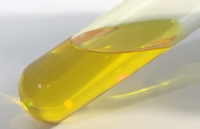
Back أوكسي ثلاثي كلوريد الفاناديوم Arabic Vanadium(V)-oxidtrichlorid German Oxitricloruro de vanadio Spanish وانادیم اکسیتریکلرید Persian Vanadiinioksitrikloridi Finnish Oxytrichlorure de vanadium French वनडियम ऑक्सीट्राइक्लोराइड Hindi Վանադիումի օքսիդ-եռաքլորիդ Armenian Ossitricloruro di vanadio Italian 三塩化酸化バナジウム(V) Japanese

| |

| |
| Names | |
|---|---|
| IUPAC name
Vanadium trichloride oxide
| |
Other names
| |
| Identifiers | |
3D model (JSmol)
|
|
| ChemSpider | |
| ECHA InfoCard | 100.028.892 |
| EC Number |
|
| MeSH | trichlorooxo+vanadium |
PubChem CID
|
|
| RTECS number |
|
| UNII | |
| UN number | 2443 |
CompTox Dashboard (EPA)
|
|
| |
| |
| Properties | |
| VOCl 3 | |
| Molar mass | 173.300 g mol−1 |
| Appearance | yellow liquid |
| Density | 1.826 g mL−1 |
| Melting point | −76.5 °C (−105.7 °F; 196.7 K) |
| Boiling point | 126.7 °C (260.1 °F; 399.8 K) |
| Decomposes | |
| Vapor pressure | 1.84 kPa (at 20 °C) |
| Structure | |
| Tetrahedral | |
| Hazards | |
| GHS labelling: | |
  
| |
| Danger | |
| H301, H314 | |
| P280, P301+P310, P305+P351+P338, P310 | |
| NFPA 704 (fire diamond) | |
| Lethal dose or concentration (LD, LC): | |
LD50 (median dose)
|
140 mg kg−1 (oral, rat) |
| Related compounds | |
Related vanadiums
|
|
Except where otherwise noted, data are given for materials in their standard state (at 25 °C [77 °F], 100 kPa).
| |
Vanadium oxytrichloride is the inorganic compound with the formula VOCl3. This yellow distillable liquid hydrolyzes readily in air. It is an oxidizing agent. It is used as a reagent in organic synthesis.[1] Samples often appear red or orange owing to an impurity of vanadium tetrachloride.[2]
- ^ O'Brien, Michael K.; Vanasse, Benoit (2001). "Vanadyl Trichloride". Encyclopedia of Reagents for Organic Synthesis. doi:10.1002/047084289X.rv004. ISBN 0-471-93623-5.
- ^ F. E. Brown; F. A. Griffitts (1939). "Hypovanadous Oxide and Vanadium Oxytrichloride". Inorganic Syntheses. Vol. I. pp. 106–108. doi:10.1002/9780470132326.ch38. ISBN 978-0-470-13232-6.
{{cite book}}:|journal=ignored (help)
© MMXXIII Rich X Search. We shall prevail. All rights reserved. Rich X Search
